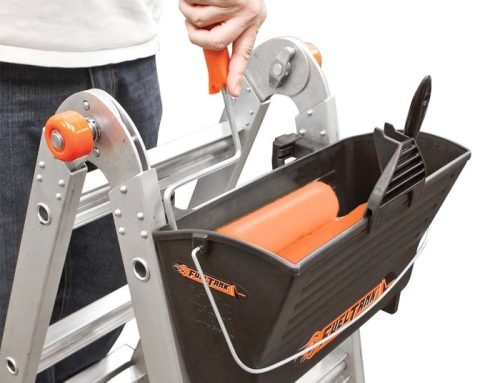“Is this safe” is a question we should all ask ourselves before we do many things. Crossing the road whilst being distracted, sticking our hands into somewhere we can't see, or carrying out electrical work standing in a puddle – these are all things that can be fraught with danger but easily avoided with a simple mental risk assessment. The question “is this safe?” ought to be followed up with “if not, how can it be done safely?” and perhaps a third question is asking yourself “is this best left to the professionals?”
We know from the ‘Idiots on Ladders’ portion of the Ladder Association's Ladder Safety Month that even the professionals can get it wrong at times; sometimes even experienced ladder users, and those who should know better, misuse ladders and put themselves at risk. Vertikal.net also has a rogue’s gallery called the Death Wish series, which features submissions from around the world, showing people using ladders in terrible set-ups, some of which are straight out of a health and safety nightmare.
A common mistake seen on these galleries is people setting a ladder up on the roof or flat bed of a van. Sure, this gives you extra height, but at what cost? There's no way you can get the right angle on the ladder when it is set up like this; and a vehicle is not a safe or stable base, even with the handbrake on. It's not uncommon to see pictures of people using a ladder set up in the basket of a cherry picker, a total waste of resources and a dangerous idea to boot. These images are hilarious at first glance, especially so is the example of workmen clearing guttering using a scissor lift they've left on the back of the truck used to transport it to the site, but when you put yourself in their shoes it's simply mind boggling to try to understand the thought process, or the lack of a thought process.
Other common mistakes are over-reaching, or setting ladders up next to each other with a third strapped between them to make a ramshackle work platform or temporary scaffold. Some properties with extensions create new rooflines can be hard to access, but the answer to this problem is to use the correct ladders or another method of height access, and not to rig some awful set-up with the wrong ladders and hope for the best.
There are ladder staging kits you can buy which allow you to turn two standard ladders into a mini-scaffold platform, so why take the risk of making your own version? Of course, we understand that no-one wants to spend so long on a job that they lose out on future work or impact the timescales for jobs already booked in. However, remember if you're in hospital with two broken legs. then you'll be out of work for much longer than you want to be. In the worst cases, people injured on ladders suffer life changing injuries that put them out of work for life, so it pays to be careful.
Sometimes it helps to look at your ladder set-up from a different angle, and from a distance. Hazards you might not see from the ground can become evident when you take a few steps back. This also gives you some thinking time to ascertain whether you're being as safe as you can be. Everyone makes mistakes now and then, but the time when you're using a ladder should not be one of them. At best, you'll end up in the Death Wish series, or be one of the Idiots on Ladders, and at worst you'll end up in hospital.
Ask yourself “is this set-up safe?”, and if it's not, invest in the right equipment. Our ladders are competitively priced and delivered the next day in most cases, so for the sake of 24 hours, do the job right the first time and keep yourself safe.






Leave A Comment
You must be logged in to post a comment.